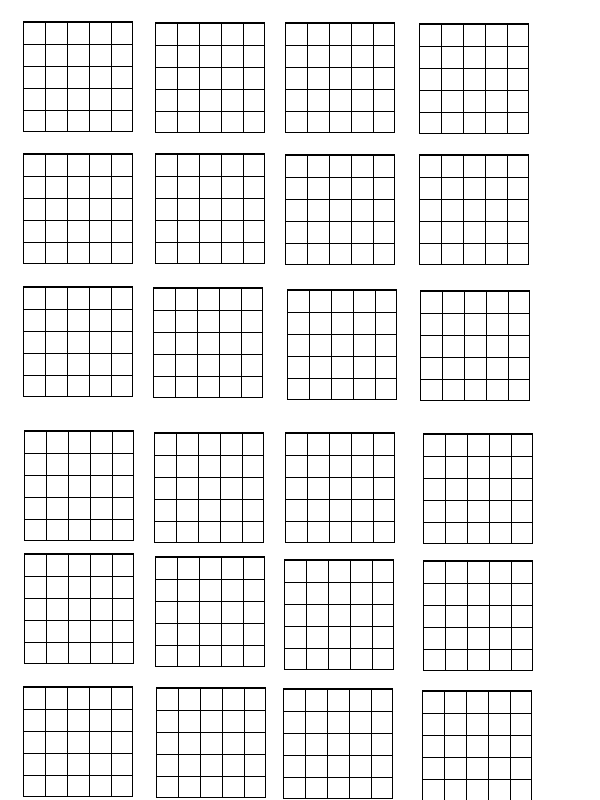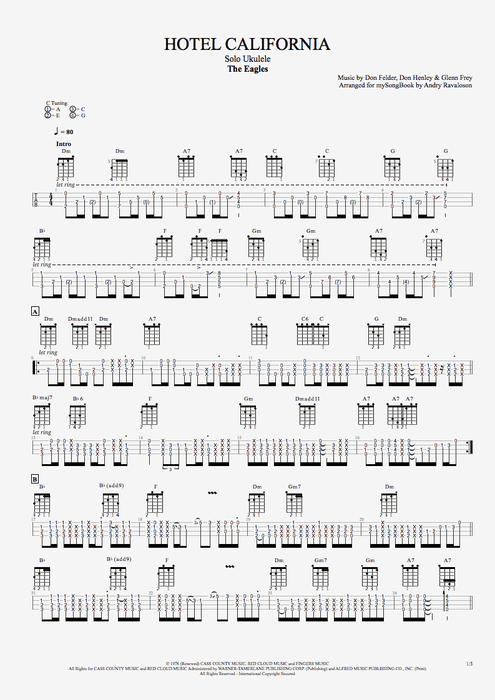Ukulele Chord Chart (Standard GCEA) Author: Jon Thysell Created Date: 6/6/2013 10:55:41 PM. Ukulele Chords The chart below shows the basic ukulele chords for the standard tuning, gCEA. If you are new to the ukulele, or a beginner having just acquired your first instrument, whether it's a Soprano, Concert or Tenor, these easy ukulele chords will.
Ukulele scales are a byproduct of a family of notes that sound pleasing together – usually a key. They serve as the foundation to a tonality (major or minor).
Since the fretboard of an ukulele is a crazy matrix, it's very useful to have scale charts available for reference as you study.
Free PDF Scales Collection
The best resource I can offer you here is this huge collection of over 150 pages of ukulele scale reference diagrams and charts in PDF. This free bundle of files includes 14 scale types and a guide on implementing them.

Each page looks like this and contains two different chart variations: notes and scale degrees.
This collection contains a whole book's worth of charts and instruction and is a detailed and expansive guide to the notes on the fretboard. And it's available to you for free.
Once you download and extract the .zip file (just double click on most computers), you'll have 15 PDF files of uke scales:
- Read Me – How to Learn Scales
- Major (Ionian Mode)
- Minor (Aeolian Mode)
- Major Pentatonic
- Minor Pentatonic
- Blues
- Dorian Mode
- Phrygian Mode
- Lydian Mode
- Mixolydian Mode
- Locrian Mode
- Harmonic Minor
- Melodic Minor
- Diminished (Whole-Half)
- Whole Tone
Tabs of Ukulele Scales:
Basic Major Scales
Root position open scales with fingering diagrams.
Chromatic Scale
All 12 Western notes in scale form shown with alternate fingerings. Can used be used as a 'sheet music to tab converter.'
C Major Scale Variations
How to play the basic C scale normally, in 3rds, harmonized, and more. Great for deepening your knowledge of the scale.
The first two measures of each staff shows the scale in it's lowest position starting from the root and the last two measures are an octave higher. If you play an ukulele with a high-g then the low ukulele scales might sound off, but the note locations are the same – just in different octaves. The 'spelling' is to the right of the link and based off of the root major scale.
- Major Scales (Ionian mode) – 1 2 3 4 5 6 7
- Natural Minor Scales (Aeolian mode) – 1 2 b3 4 5 b6 b7
- Dorian Mode Scales – 1 2 b3 4 5 6 b7
- Mixolydian Mode Scales – 1 2 3 4 5 6 b7
- Lydian Mode Scales – 1 2 3 #4 5 6 7
- Phrygian Mode Scales – 1 b2 b3 4 5 b6 b7
- Major pentatonic scales – 1 2 3 5 6
- Minor Pentatonic Scales – 1 b3 4 5 b7
- Blues Scales – 1 b3 4 #4 5 b7
UkeBuddy is a great tool for finding other scales. It's a bit hard to look at for my eyes, but the information is all there, provided you have an internet connection.

How to Play Basic Major & Minor Ukulele Scales
C Major
C D E F G A B C
G Major
G A B C D E F# G
F Major
F G A Bb C D E F
A Minor
A B C D E F G A How to get sparkle cursor on tumblr.
E Minor
E F# G A B C D E
D Minor
D E F G A Bb C D
A Major
A B C# D E F# G# A
All About Modes:
Confused about what the modes are? Me too. This page demystifies the theory behind them.
A player's most important piece of foundational knowledge is, without a doubt, the notes on an ukulele fretboard.
They hold the key to everything and yet, these 48 little destinations get pushed aside by almost everybody! They are like the times tables of your uke – not fun, but useful and necessary.
Contents:
The Chromatic Fretboard Layout
GCEA fretboard diagram PDFs
Diagrams for other tunings
Memorizing the fretboard
Before we get too excited about what is where (if you really can't wait, click the button), it's nice to have a vague idea why the notes are laid out the way they are on an ukulele fretboard.
The Chromatic Ukulele Fretboard Layout:
Western music uses 12 notes, in this order:
It's called the chromatic scale. Once you get to the end, it repeats back to A. This chromatic scale also happens to be exactly the same as the A-string. If you were to play every note on your A-string, in order, starting on the open A note, you would be playing the above line of letters.

Each page looks like this and contains two different chart variations: notes and scale degrees.
This collection contains a whole book's worth of charts and instruction and is a detailed and expansive guide to the notes on the fretboard. And it's available to you for free.
Once you download and extract the .zip file (just double click on most computers), you'll have 15 PDF files of uke scales:
- Read Me – How to Learn Scales
- Major (Ionian Mode)
- Minor (Aeolian Mode)
- Major Pentatonic
- Minor Pentatonic
- Blues
- Dorian Mode
- Phrygian Mode
- Lydian Mode
- Mixolydian Mode
- Locrian Mode
- Harmonic Minor
- Melodic Minor
- Diminished (Whole-Half)
- Whole Tone
Tabs of Ukulele Scales:
Basic Major Scales
Root position open scales with fingering diagrams.
Chromatic Scale
All 12 Western notes in scale form shown with alternate fingerings. Can used be used as a 'sheet music to tab converter.'
C Major Scale Variations
How to play the basic C scale normally, in 3rds, harmonized, and more. Great for deepening your knowledge of the scale.
The first two measures of each staff shows the scale in it's lowest position starting from the root and the last two measures are an octave higher. If you play an ukulele with a high-g then the low ukulele scales might sound off, but the note locations are the same – just in different octaves. The 'spelling' is to the right of the link and based off of the root major scale.
- Major Scales (Ionian mode) – 1 2 3 4 5 6 7
- Natural Minor Scales (Aeolian mode) – 1 2 b3 4 5 b6 b7
- Dorian Mode Scales – 1 2 b3 4 5 6 b7
- Mixolydian Mode Scales – 1 2 3 4 5 6 b7
- Lydian Mode Scales – 1 2 3 #4 5 6 7
- Phrygian Mode Scales – 1 b2 b3 4 5 b6 b7
- Major pentatonic scales – 1 2 3 5 6
- Minor Pentatonic Scales – 1 b3 4 5 b7
- Blues Scales – 1 b3 4 #4 5 b7
UkeBuddy is a great tool for finding other scales. It's a bit hard to look at for my eyes, but the information is all there, provided you have an internet connection.
How to Play Basic Major & Minor Ukulele Scales
C Major
C D E F G A B C
G Major
G A B C D E F# G
F Major
F G A Bb C D E F
A Minor
A B C D E F G A How to get sparkle cursor on tumblr.
E Minor
E F# G A B C D E
D Minor
D E F G A Bb C D
A Major
A B C# D E F# G# A
All About Modes:
Confused about what the modes are? Me too. This page demystifies the theory behind them.
A player's most important piece of foundational knowledge is, without a doubt, the notes on an ukulele fretboard.
They hold the key to everything and yet, these 48 little destinations get pushed aside by almost everybody! They are like the times tables of your uke – not fun, but useful and necessary.
Contents:
The Chromatic Fretboard Layout
GCEA fretboard diagram PDFs
Diagrams for other tunings
Memorizing the fretboard
Before we get too excited about what is where (if you really can't wait, click the button), it's nice to have a vague idea why the notes are laid out the way they are on an ukulele fretboard.
The Chromatic Ukulele Fretboard Layout:
Western music uses 12 notes, in this order:
It's called the chromatic scale. Once you get to the end, it repeats back to A. This chromatic scale also happens to be exactly the same as the A-string. If you were to play every note on your A-string, in order, starting on the open A note, you would be playing the above line of letters.
The 12th fret marks what's called an 'octave' – the same note, a full do-re-me-fa-so-la-ti-do scale away. That means once you get to the 12th fret, everything repeats!This is true of all the strings. The open strings of an ukulele are: G-C-E-A. What are the note on the 12th fret of the ukulele? G-C-E-A one octave above!
Takeaway: You only really need to learn the notes of the ukulele up to the 11th fret.
Out of the chromatic scale we can find 7 natural notes:
They are considered 'natural' because they are not altered with sharps or flats.
A sharp (#) raises the pitch of the note a half step. A flat (b) lowers the pitch of the note a half step. A half step is one fret on the ukulele.
These flat or sharped notes are called 'enharmonics'and each has two names. There are 5 enharmonics:
Because of the way the 12 notes are spaced on the ukulele fretboard, there's an enharmonic between every natural note and the next except:
- B and C
- E and F
Ukulele Chord Chart Printable
As long as you can remember that B/C and E/F are always next-door neighbors, you can always figure out the chromatic scale.
Here's a diagram of where they happen to fall on the fretboard of an ukulele.
Offsetting the Chromatic Scale for Each String:
Since the chromatic letter line repeats from G#/Ab back to A again, you can start on any note and get the same order, every time. This is exactly what happens with the other three strings.
The E-string is simply:
The C-string:
The G-string:
Put it all together and you get your first rough note map of the ukulele fingerboard:
Enter the Matrix
Understanding the notes on a piano keyboard is easy compared to an ukulele fretboard. This is because there is only one place for each note – middle C only exists in a single spot.
Ukulele Tuning
On ukulele however (with a few exceptions), each note exists in several places. I like to think of this as the fingerboard 'matrix.' Because of how the chromatic scale lands on each string, the picture gets much more challenging to understand. Finding the 'right' note becomes a hefty chore. Not only do you have to locate options, but you must decide which to use to play the song!
Now that you have an idea why things are the way they are, let's get down to business and rock that fretboard chart for your uke!
Charts for GCEA Ukulele Fretboard Notes
There's not much to a fingerboard chart. One set of lines run horizontal and represent the strings. The others are vertical and represent the frets. The notes are shown in each finger space. Simple.
Here are several ukulele fretboard note charts in different formats for reference.
In some circumstances a .jpg file might be useful. Click on the image to get the full-size version:
If you want a fancy version with highlighted natural notes, here's a colored fingerboard chart:
Finally, I put together a high-res PDF download with several fretboards to a page that you can use to practice memorizing the fretboard.
Other Tunings:
Most people who land on this page will be looking for the above info. But for the sake of covering all bases, here are charts for the other main tunings. If you'll notice, everything is the same, only the start location changes. The chromatic scale in action again!
Memorizing the Notes of the Fretboard
One of the first battles you face on the way to being a more competent ukulele player is learning the notes and where they are located on the fingerboard. Not just: [pause] '…there's F!', but more like:
BOOM!
You want to be able to instantly find the nearest location of that one note you are looking for. It takes time and you can always be faster, but familiarity with your ukulele will take you a long ways.
The Process
I suggest starting by learning the natural notes up to the 3rd fret. Since the C major scale is made up of only natural notes, it is a great place to begin.
I could explain it here, but Brett over at Ukulele Tricks does a great job demonstrating the basic first position C major scale.
That basic shape covers the bottom three strings, so all you have to add is the open G-string and A on the 2nd fret, G-string:
Next, work on studying all the natural notes up to the 5th fret. That step just adds all the notes on the 5th fret and two on the 4th fret, G and C strings to what we already have from the previous step.
Work your way up the fretboard (by frets or by string if you like) and learn the rest of the natural notes. It's all just a big C scale.
Instead of trying to do it all at once, I'd proceed studying from the 5th fret by adding two frets worth of natural notes at a time. This is more manageable and will teach you to see 'zones' that exist between note patterns.
From there, you just need to fill in the blanks with enharmonics.
Ukulele Chord Chart With Finger Numbers
As you're studying each portion of the fretboard and pushing back the darkness that surrounds the notes on your ukulele, you'll need some ideas for drills and exercises.
Scales probably make the most sense for learning the fingerboard because you are learning notes anyways. Just like the C scale familiarizes most people with the natural notes inside the first 3 frets, any other scale can teach you the notes that live in between and higher up the neck. Here is a tab of major scales and a page of video lessons with tab:
- The Scale Files (video and tab)
- In case you need it: How to read tab
Ukulele Chord Chart
Just play and think about the notes. Simple, but once you learn a song, do you really think about the notes or just where your fingers go? If you run through the names of the notes as you play them you can kill two birds with one stone. This is especially important if you learn just from tabs as there is nothing forcing you to even care about the notes. Avb public school holiday homework 2017.
Find a note in all locations. If you have metronome, put it going slowly, if not, just practice this evenly (and slowly) by counting in your head or tapping your foot. Choose a note and locate it on any string. Once you find the note, play it on a click (metronome or virtual – '1 2 3 4…'). Find the note on the next string and play it on the next click (I said go slowly right?). And the next and the next until your cover all the strings.
There are some strings (depending on how many frets you have to work with) that will have two note locations. I suggest you practice playing those too. Then pick another note to find the locations of. Try doing this with all the different notes (enharmonics too!). For example, to do this exercise with the G note it would look like this:
- Open G string – 'click/pick'
- 12th fret, G string – 'click/pick'
- 7th fret, C string – 'click/pick'
- 3rd fret, E string – 'click/pick'
- 15th fret, E string – 'click/pick'
- 10th fret, A string – 'click/pick'
Ukulele Chord Chart Blank
Write it out. Print out some copies of a blank fingerboard chart and fill in the blanks using whatever order you like (natural notes first, string by string, fret by fret, etc…). Study the location of those notes!
